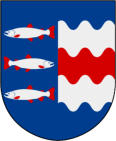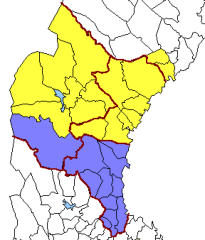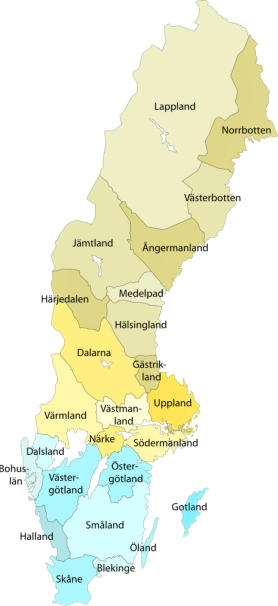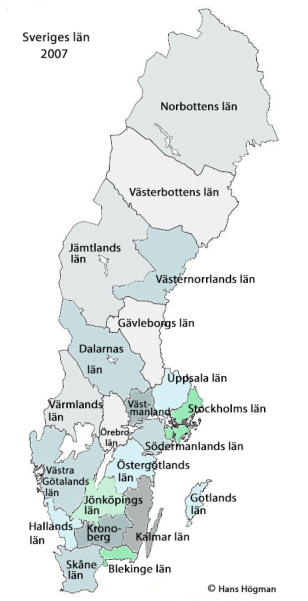
Copyright © Hans Högman 2019-12-24


Introduction - Sweden
Sweden is traditionally divided into three major
“lands”, from north to south; Norrland, Svealand
and Götaland. Prior to 1809 Sweden had a fourth
land: Finland.
Norrland (meaning Northland) is a land comprising
the northern half Sweden.
The subdivision into counties is from 1634 and its
sole purpose of the counties is regional
administration.
The Swedish term for county is Län.
Norrland County
The County of Norrland or the Governorship of
Norrland (Ståthållardömet Norrland) was an
administrative division of Sweden that existed
between 1620 and 1634.
The Governorship of Norrland covered the entire
northern part of present-day Sweden, from
Gästrikland northwards, except Jämtland and
Härjedalen, which then belonged to Denmark-
Norway.
It also included northern Finland, where the border
with the Governorship of Finland ran south of the
city of Vasa on the coast, and extended inland to the
northeast.
History of Västernorrland County
Västernorrland County (Västernorrlands Län) was
created under the Constitution of 1634. The county
then covered the whole of Norrland.
A few years later, in 1638, the county
of Västerbotten was established by
detaching the provinces of
Västerbotten and Lappland from the
County of Västernorrland.
The Image to the right shows the coat
of arms of Västernorrland.
Västernorrland was also called Hudiksvall County
after the capital city of Hudiksvall.
The county was divided into two counties on 5
September 1645:
•
Härnösand County, with Härnösand as the
county seat, including provinces Ångermanland,
Medelpad and Jämtland.
•
Hudiksvall County, with Hudiksvall as the county
seat, including provinces Gästrikland, Hälsingland
and Härjedalen.
These two counties were merged back into one
county on 13 March 1654, which was named
Västernorrland County. At first Hudiksvall was the
seat of the county, but was later moved to Gävle and
Gävleborg Castle.
On 29 June 1762 the county was again divided into
two parts:
•
Gävleborg County, with Gävle as its seat, and
included provinces Gästrikland, Hälsingland and
Härjedalen.
•
Västernorrland County with Sundsvall as its seat
and included provinces Ångermanland, Medelpad
and Jämtland.
In 1778, Härnösand again became the county
seat.
On 7 May 1810, the provinces of Härjedalen and
Jämtland were separated from these two counties to
form the County of Jämtland, with Östersund as its
seat.
At the same time, the north-eastern parishes
Nordmaling and Bjurholm in Ångermanland, were
separated from Västernorrland County and added
to Västerbotten County.
Summary
1620 - 1634
Norrland County or rather Governorship of
Norrland (Ståthållardömet Norrland) was an
administrative division in Sweden that existed 1620-
1634.
1634
Västernorrland County (Västernorrlands Län) was
established under the constitution of 1634 and
covers the whole of Norrland. The county was also
called Hudiksvall County after the residential town of
Hudiksvall.
1638
The county of Västernorrland is divided and
northern Sweden (today's provinces of Lapland,
Västerbotten and Norrbotten) forms the county of
Västerbotten (Västerbottens Län) in 1638, with
Umeå as its seat.
The part of Västernorrland County located south of
Västerbotten County retained the name
Västernorrland County.
Västerbotten County also included northern
Finland, as far as to the Kemi River. Southwards in
the Finnish part, Västerbotten stretched down to
Österbotten County (the border between
Västerbotten and Österbotten was the border
between Sweden proper and Finland).
1645
The part of Norrland that retained the name
Västernorrlands län after the division in 1638 is
divided into two parts in 1645:
•
Härnösand County, with Härnösand as the
county seat, included the provinces of
Ångermanland, Medelpad and Jämtland.
•
Hudiksvall County, with Hudiksvall as its seat
and comprising Gästrikland, Hälsingland and
Härjedalen.
1654
The two counties, Härnösand County and Hudiksvall
County, are merged again to form Västernorrland
County. In the beginning Hudiksvall was the county
seat, but later it was moved to Gävle and Gävleborg
Castle.
Västernorrland County now
included the provinces of
Ångermanland, Medelpad,
Jämtland, Gästrikland,
Hälsingland, and
Härjedalen.
The map to the right shows
Västernorrland County in
1654 (both the yellow and
blue provinces). Wikipedia.
1762
Västernorrland County is divided into two parts in
1762:
•
Gävleborg County with Gävle as the county seat
and included provinces Gästrikland, Hälsingland
and Härjedalen (blue colour in the map above).
•
Västernorrland County with Sundsvall as its
county seat and including provinces
Ångermanland, Medelpad and Jämtland (yellow
colour in the map above). From 1778, Härnösand
again became the seat of the county.
1809
The Finnish part of Västerbotten County is lost
with the loss of Finland to Russia in 1809.
1810
•
Jämtland County was formed in 1810 when the
county of Jämtland was detached from
Västernorrland County and the county of
Härjedalen was detached from Gävleborg County.
Together, the provinces of Härjedalen and
Jämtland form the county of Jämtland, with
Östersund as its seat.
Västernorrland County now consists of provinces
Medelpad and Ångermanland and Gävleborg
County of provinces Gästrikland and Hälsingland.
•
Norrbotten County is formed in 1810 from the
northern part of Västerbotten County.
Maps of Counties and Provinces
of Sweden
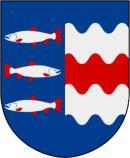
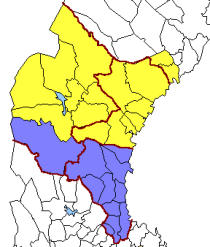
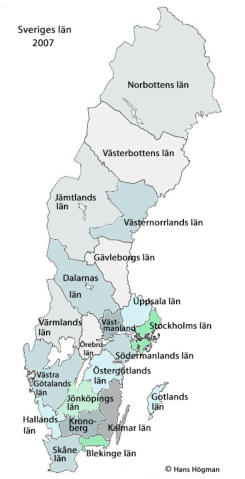
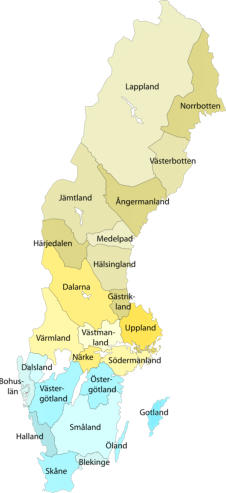
County divisions of
Norrland
Above, maps of Sweden’s counties (län) and
provinces (landskap).
The map to the left shows Sweden’s counties as of
2007 and the map to the right shows Sweden’s
provinces.




























































































































































































































































































































































































